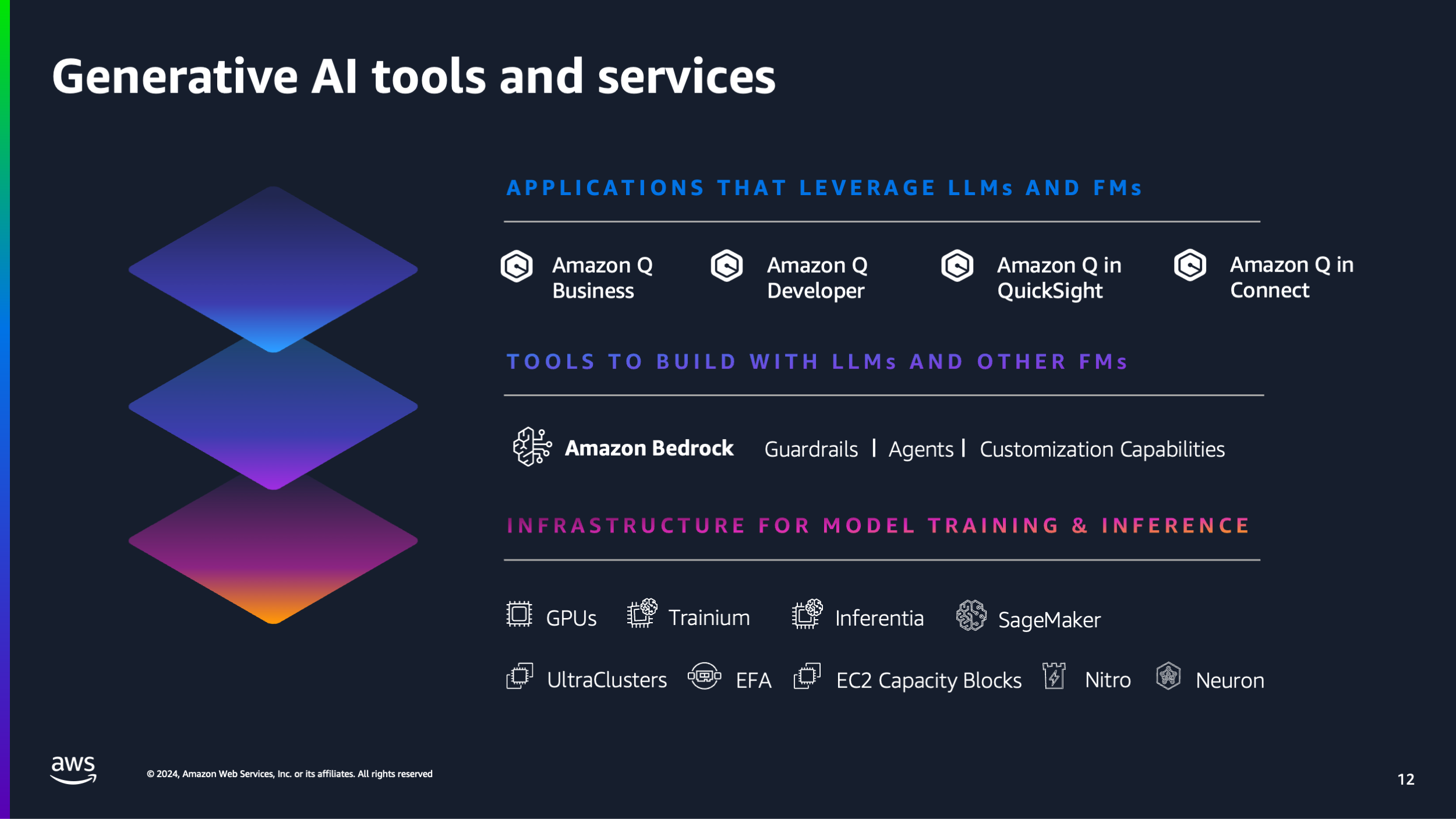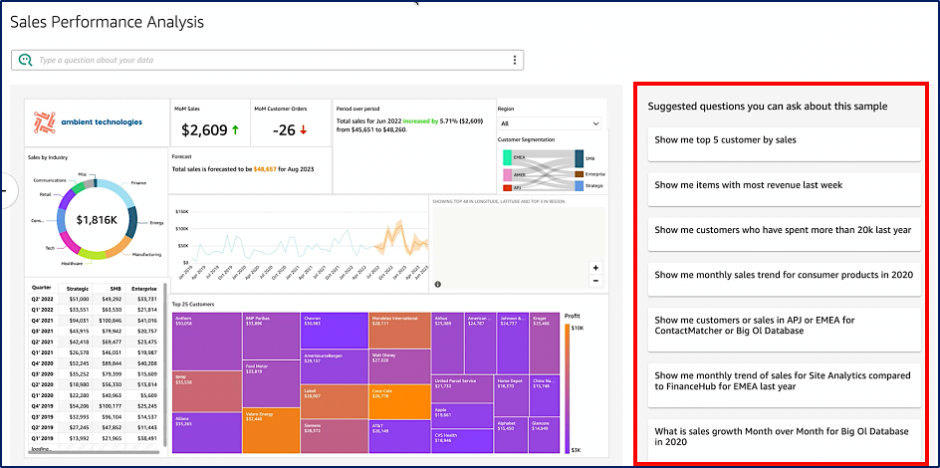
Adding to the drumbeat of AI announcements for both itself and the industry, Amazon has just announced that Amazon Q, its AI assistant-and-then-some, is available in GA. We believe that Q is a significant entrant into this market thanks to both Amazon’s ability to execute on a vision of this scope and its perspective that AI can bring significant evolution to how work is performed today. To consider the potential impact of Amazon Q from multiple angles, this article includes contributions from Moor Insights & Strategy principal analysts Jason Andersen, Melody Brue, and Robert Kramer.
What is Amazon Q?
Amazon Q is not an AI tool per se. It’s more of a fabric that supports many different capabilities—and, in a sense, different profiles. This is a bit of a departure by Amazon; whereas other AI vendors tend to focus on a set of disparate applications or agents being used with a common AI model, Q is more reminiscent of Amazon’s Alexa consumer device.
More specifically, like Alexa its value is that it’s a concierge to the Amazon world, but it also goes beyond that by providing a very broad set of capabilities depending on who is using it. At first this is kind of hard to get your mind around if you look at the present state of most AI assistants as a tool for carrying out a task. Amazon has gone significantly deeper than that. For instance, in the documentation for Q Developer there is a lot of reference material for how to understand AWS resource usage or security attributes. While other developer-focused AI tooling is often very specific to the code, Amazon’s more holistic approach is better suited for DevOps or smaller IT teams where people need to wear a lot of different hats. This is a really nice design point.
Another example of this fabric concept is how Q’s capabilities are deployed and marketed. There are four different ways to consume Amazon Q. First, Q Business is targeted at knowledge workers. Second, Q Developer focuses on traditional application developers. And then there are Q capabilities now available within Amazon’s existing QuickSight and Connect offerings, which are targeted at data science and customer service use cases, respectively. We’ll now look at each of these in turn.
Amazon Q Business
Amazon Q Business is an AI-powered enterprise assistant aimed at simplifying information access and streamlining workflows. As with other AI assistants, users can query data repositories, summarize findings, and engage in dialogues. Beyond that, though, Q Business users can also build secure, private AI assistants with customizable responses aligned with company guidelines. (More on that in the next section.)
Amazon Q connects to multiple popular data sources, including Amazon S3, Salesforce, Google Drive, Microsoft 365, ServiceNow, Gmail, Slack, and Zendesk. As a result, it can deliver accurate and relevant answers to an enterprise’s business questions. For security and privacy, Amazon Q only returns information that the requestor is authorized to see based on their role.
In the new GA release, Amazon has added a new content creation mode to the Web experience. In this mode, Amazon Q Business utilizes internal GAI models for tasks such as summarizing responses and composing personalized emails without accessing enterprise content. Pre-built data connectors and plugins facilitate data integration and enable actions within enterprise systems such as Jira and Salesforce.
Administrative controls enable global and topic-level configurations, allowing organizations to manage access permissions and effectively enforce response generation from enterprise data sources. Enhanced security measures, including AWS IAM Identity Center integration, ensure secure user identity management across applications.
Q Apps in Amazon Q Business
Within Amazon Q Business, Amazon has introduced Q Apps, which enable employees to generate customized applications without coding expertise. By describing their requirements in simple language, users can prompt Amazon Q Apps to create tailored applications to tackle specific organizational tasks.
For example, tracking employee performance reviews can be time-consuming in many companies because it involves gathering and compiling feedback from multiple sources into a coherent and usable format. With Amazon Q Apps, an HR professional could describe their needs and specify parameters such as performance metrics, evaluation criteria, and feedback sources. Amazon Q Apps should then be able to generate an app that automates the process. The app could have features such as customizable evaluation forms, automated reviewer reminders, and built-in analytics to analyze performance trends.
Amazon Q Apps has the potential to streamline processes and foster innovation by enabling teams to develop applications that drive business outcomes. Equally important, it reduces dependency on technical resources, empowering non-technical staff to address challenges and seize opportunities more effectively without tying up IT staff in the process.
At a high level, Amazon Q Business appears to strike a unique balance between powerful AI-driven tools and granular controls. Users benefit from convenient information access and content creation capabilities, while administrators maintain comprehensive oversight and security protocols. This emphasis on accurate, trustworthy results could make it a compelling choice for organizations seeking to streamline workflows while protecting their data governance. It could create a significant competitive edge—for both Amazon and its customers—if it can also deliver superior accuracy.
Amazon Q Developer
While Q Apps focuses on the no-code user, Q Developer’s focus is on more traditional software development. Amazon provides a similar set of features as what you see from competitors such as GitHub and Google. For example, developers can leverage their own IDE or other popular IDEs via plugin. But Q Developer goes beyond that. Besides the DevOps features mentioned above, there are also more mature capabilities such as code planning, debugging, and optimization assistance.
The area that I found of most interest was how Amazon is highlighting some of the more mundane tasks that developers face. That is not always the case in this product category, where the emphasis tends to fall on developing new apps. For example, Amazon specifically references how much easier it is to perform Java upgrades. If you’ve ever had to do one of these yourself, you know what a chore it is. It’s a pain point for enterprises, many of which now take a “cold dead hands” approach of updating older JDKs and apps only when they’re forced to. So if Amazon’s benchmarks for this are even close to accurate in the real world, this functionality could help out the relevant IT teams immensely.
Amazon has called Q Developer an “evolved approach” to application development. I think that statement has a lot of merit given the sensitivity Amazon has shown for how developers work and where they spend their time.

Amazon Q from an Enterprise Data Perspective
Amazon Q in QuickSight is all about making data better as it provides business analysts, users, and executives access to view, format, and customize data to use throughout an organization. Business analysts are able to use natural language prompts to build dashboards, speeding up the creation of visuals and insights. Users can also go beyond dashboard data for answers to their questions with Amazon Q. This enables users to craft interactive data stories with detailed analysis, trends, and recommended actions, all shareable across the organization and with proper security measures in place. With Amazon Q, executives can quickly get summaries to answer business questions, instead of relying on predefined data models and dashboards.
Here are a few examples. For sales forecasting, Amazon Q can be used to predict sales by month, quarter, season, or product. It generates outputs showing historical sales forecasts based on requested parameters. Additionally, it analyzes pricing data, customer behavior, and competitive pricing to ensure that the right amount is charged to maximize revenue; it can also determine how much of a discount can be offered without affecting profit.
AWS Supply Chain utilizes machine learning for advanced supply chain planning. A soon-to-be-released Amazon Q feature within AWS Supply Chain will equip inventory, supply, and demand managers with relevant data-driven answers to enhance decision making in the supply chain. Managers and planners will have the ability to use what-if scenarios to assess the implications of different supply chain strategies. Amazon Q can also enhance supply chain management by offering solutions during disruptions such as production problems or weather-related shipping delays. It helps identify alternative products or more efficient shipping routes to bypass affected areas. Additionally, Amazon Q provides insights for timely product reordering and selecting suppliers who deliver on schedule. It also supports sustainability efforts by analyzing supplier data to choose those using eco-friendly materials and optimizing shipping routes to reduce emissions.
Q Meets CX: Amazon Q Connect
Amazon Q in Connect is an advancement from its predecessor, “Amazon Connect Wisdom,” which was a machine learning solution aimed at equipping employees with unified knowledge for customer service. Within Connect, Amazon Q can now provide contact center agents with recommended responses to customer inquiries, guide them through sales processes, and help expedite issue resolution. This is done by employing real-time conversation data and integrating it with company information to offer contextual guidance and suggest the best next actions for every agent.
Because Amazon Q has role-based controls on information access, it works well in an escalation model for contact centers where there are clear definitions of who has access to which customer information at each level.
A Different Approach to AI Sourcing and Training
As we see continued adoption of AI features in the enterprise, it is nice to see how vendors are responding—Amazon included. That said, Amazon has taken a different approach to sourcing its AI than the other major AI players; while it’s too early to judge the relative merits of Amazon’s approach, it needs to be noted.
One trend coming to the fore with AI assistants is where the assistant is getting its intelligence. Some companies such as Microsoft or Google have their own AI models for this, or they might make the decision to use a public model such as ChatGPT or Anthropic. Amazon believes that it’s unlikely that any one model will be all things to all people and that it should be up to each service owner or team to decide the right fit based upon capability and performance. That belief led to Amazon’s novel approach with Bedrock. Bedrock is an API that creates a programmatically consistent connection to different models—something like a middleware layer for LLMs. This novel concept allows Amazon to source models based upon best fit for a given task, and to more easily change models as the industry matures. (For more on Bedrock, check out our coverage from its launch in 2023.)
It’s unclear which approach is the best. However, it’s worth noting that Amazon is pushing some responsibility to multiple LLM providers (all of which have their own standards and motivations) in terms of how their models are maintained and managed. On Amazon’s end, the company does have standards in place, as well as a documented feature called Guardrails to help provide ethical and responsible AI practices. Although it’s still too early to tell which AI practices will become industry norms, Amazon makes a valid point about LLM maturity and performance, so we shall have to see if its approach becomes a more standard practice.
All of this brings us to another enterprise concern that is gaining momentum, which is whether content that you deploy will be used to train the model. And this concern is not exclusive to Amazon. In fact, GitHub goes out of its way to make its position clear that it will not use your proprietary code to train Copilot. In the case of Amazon, it’s very similar. In Q Business and Q Developer Pro, Amazon will not use your proprietary data for model training. But in the free version of Q Developer, Amazon may use certain content for service improvement, for example to provide better responses to common questions, fix Amazon Q operational issues, or for debugging or model training. Therefore, it’s recommended to use the Pro version of Q Developer for serious production efforts.
Wrapping Up
In short, Amazon Q is a very interesting approach for integrating AI into Amazon’s platforms. The approach to each type of user that Q targets is more evolved and focused on making their jobs better versus merely simplifying a task. That is critical, because AI in the business world shouldn’t be about making incremental improvements to deliver a better bicycle. It’s about giving every one of us a flying car.

























































































